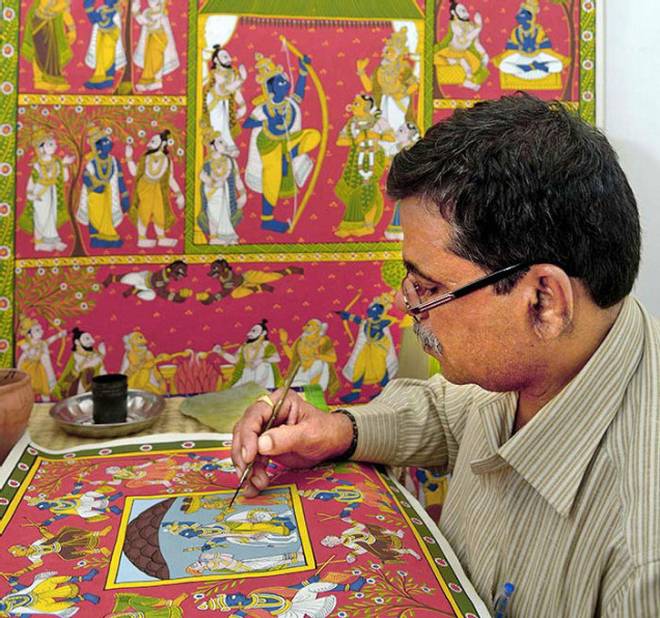Cheriyal: Indian Scrolls with a Story

Image Courtesy: Rangan Datta
HISTORY
Cheriyal art originates from the village of the same name, located around 85km away from Warangal in Telangana. The scrolls that are characteristic of this form are considered to be variants of Nakashi art. Cheriyal scrolls depict an array of mythological motifs that point to the primordial past of the Indian subcontinent. Stories form the Puranas and Epics often find expression on these elaborate scrolls.
The form does draw influences from others such as the Madhubani, but possesses a distinct local flavour that enables viewers to tell these forms apart. The distinctness of the Cheriyal comes from the aspect of storytelling that is infused into these paintings. Each scroll is drawn onto khadi cloth, and starts with an image of Ganesha, followed by Sarasvati. This is said to be symbolic of the homage paid to deities to seek their blessings.
CHERIYAL: THE PROCESS
Cheriyal was initially made using tamarind seed paste, along with sap and white clay. These are mixed together to make a paste, of which three coats are applied onto the cloth used. The mixture is allowed to dry for two days, following which an outline is painted using a fine, squirrel hair brush. Red colour is used for the background. Blue and yellow are used to create images of Gods, whereas brown and darker tones of used to draw demons. If human figures are to be incorporated, they are drawn in pink.

Image Courtesy: Neeharika Satyavada
The dyes used were earlier obtained from grounded sea-shells, turmeric and vegetables. Today, these organic materials are replaced by watercolour, which is mixed with tree gum before applying it onto the scrolls. The paint is quite long-lasting, and only deteriorates when it comes in contact with liquid water.
CHERIYAL TODAY:
In the contemporary context of India, the Cheriyal form seems to be pretty rare. D. Vaikuntam and his family seem to be one of the few factions that still specialise in the art form. They have passed on the techniques and skills required to make these scrolls since the 15th century, from generation to generation. Apart from making scrolls, the Vaikuntams have also adapted the form into other objects, such as masks. These altered objects also portray Indian mythology and the stories associated with it. The concerns with the art form fitting into today’s context are what led to these formalistic changes.

Image Courtesy: The Hindu

Image Courtesy: Neeharika Satyavada
Adapting the changes brought on by globalisation is always a major challenge for ancient art forms. It becomes difficult to adapt alternatives and replacements to create new dimensional aspects for these distinct art forms. However, Cheriyal Art continues to survive through the efforts of ardent craftsmen such as Vaikunthan.

